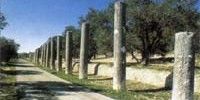Shomron National Park
January 2nd 2015

Approximately seven miles northwest of Nablus (called Shechem in Hebrew), the city where the biblical patriarch Joseph is buried, Israel tour participants can visit the remains of the ancient city of Shomron, also known as Samaria. Although there were multiple historical periods during which the city of Shomron thrived, it was also besieged and changed hands several times.
Shomron served as the capital of the Kingdom of Israel roughly 30 centuries ago, after the nation split into the Kingdom of Israel to the north and the Kingdom of Judea (based in Jerusalem) to the south, when King Solomon passed away. Later, during the Second Commonwealth, the city was awarded to Herod in the early part of the 1st century CE by the Roman Emperor Augustus. During the 2nd and 3rd centuries, Shomron flourished under Roman rule.
The ancient ruins that tour participants visit today in the Shomron National Park include remains of a fortress, walls, a plaza, private dwellings, a royal palace, a stadium and a number of structures that originally served as storehouses. One long street is lined with the remains of hundreds of columns that were built by master builder Herod the Great during his reign. These 600 or so Herodian columns once led to an impressive gate. The columns are all that’s left of a temple that Herod build as a memorial to the Roman Emperor Augustus. While walking around the ruins, look for the remains of a wall relief that archeologists believe is a depiction of battle for control of Shomron that was lost by the city’s defenders.
A highlight of a visit to the Shomron National Park is the ancient amphitheater. In 2013, the Samaria Regional Council hosted concerts and other programs in the amphitheater here in an effort to encourage visits to the ancient capital. The site currently includes a mosque which was built on top of a Crusader Church – which itself was built on a church from the earlier Byzantine period.
Walking through the archeological site is considered to be slightly strenuous by the Israel Nature and Parks Authority. Today, the Shomron National Park operates under the auspices of the Palestinian Authority, and visits must be prearranged and coordinated with the Israeli military. Popular times to visit the park include Sukkot and Passover.











